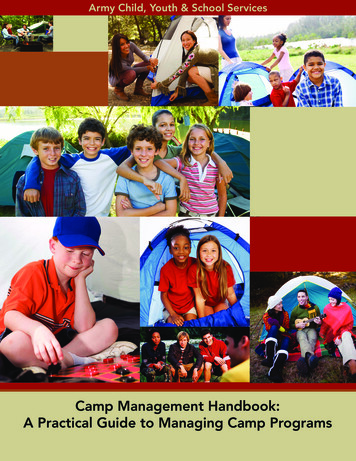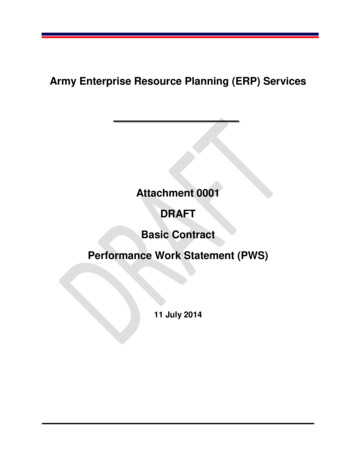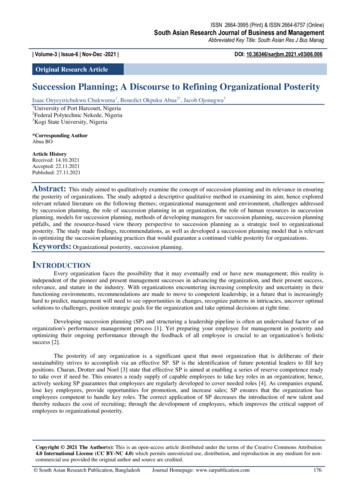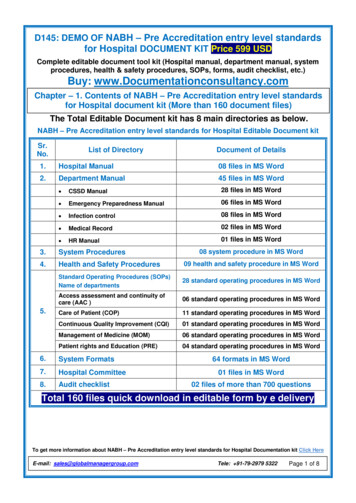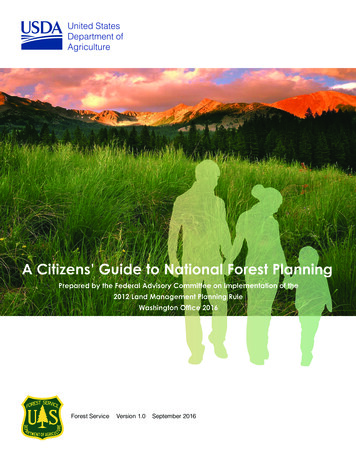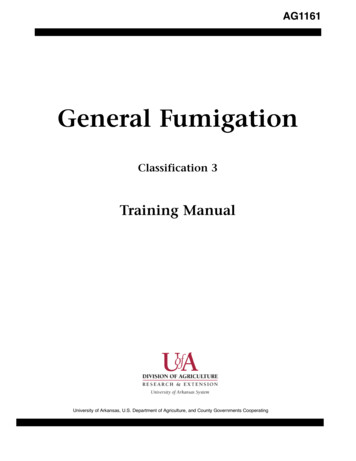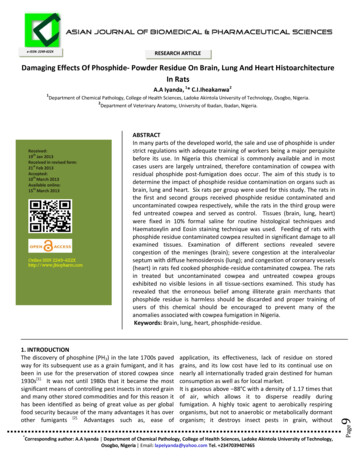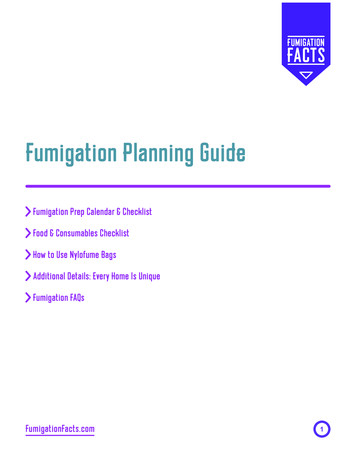
Transcription
FUMIGATIONFACTSFumigation Planning GuideFumigation Prep Calendar & ChecklistFood & Consumables ChecklistHow to Use Nylofume BagsAdditional Details: Every Home Is UniqueFumigation FAQsFumigationFacts.com1
In addition to the work performed by your fumigator, you will need to help prepareyour home for the fumigation.FUMIGATION PREPCALENDAR &CHECKLISTThis timeline is to be used as a guideline and may vary based on your location and pestmanagement service. It is the responsibility of the homeowner to have all tasks on thischecklist done before the crew arrives. Failure to do so may postpone the fumigation.Confirm necessary activities and timing with your pest management professional.As soon as possible Make accommodation arrangements for family and pets.Block areas where pets might hide in/under structures. Schedule shut-off and post-fumigation restoration of your gas service at least 48 hours in advance.*In some areas, three to five days’ notice is required.Make arrangements for cars and vehicles that may need to be parked away from the structure.Make security arrangements if needed.*Hold your mail service if needed.*If not already arranged by your pest management professional.Two to three days before emove or double-bag unsealed food and medicines.* See the “Food & Consumables Checklist”Ron Page 4 for helpful information.Make house key arrangements with your pest management professional.Move indoor and outdoor potted plants away from your home.Prune any plants or trees touching/encroaching the outside of your home.Water the soil up to 18 inches from the outer walls of your home.Retract all awnings.Return all signed contracts to your fumigation and/or termite company.*Special bags are used and are available from your pest management professional. See “How to Use Nylofume Bags” on Page 6 for instructions.One day beforeWater the soil next to the foundation.Open waterproof covers on mattresses and pillows if they do not have built-in air vents.*Take pets to boarding or other location.Notify neighbors to make them aware of your upcoming fumigation treatment. To allow access for tarping, move cars and vehicles not being used the day of fumigationseveral feet away from the structure. Cars and vehicles may be left inside your garage butmust be fully accessible (doors and trunk left unlocked).*If waterproof covers have built-in air vents, they do not need to be opened.FumigationFacts.com2FOCONCH
FUMIGATION PREPCALENDAR &The day of fumigationCHECKLIST rovide house keys to your pest management professional if needed, as well asPthe best way to contact you during the fumigation. Evacuate all people, pets and plants from the structure. Confirm gas company restoration appointment.* Turn off automatic timers, sprinkler systems, air conditioning, etc. Turn off electrical heating elements such as those in heaters, computers, pianos, organs,pet habitats, etc. Extinguish all pilot lights (hot water heaters, ranges, ovens, dryers, etc.).** Open all cabinets, drawers, closets and interior doors.*If not already arranged by your pest management professional.**In California, this is handled by the gas utility.After the fumigation ollow your state’s regulations and don’t re-enter your home until it has been tested and certifiedFfor re-entry by a licensed fumigator. Meet with the gas company to restore service.* Make sure not to remove the clearance noticeon the gas meter, as the gas company will need it to turn the gas back on. Turn back on any devices and timers. It is not necessary to wash dishes, linens, clothing, etc., as the fumigant is a gas that will dissipatefrom the structure and its contents. Enjoy the peace of mind that the termites are gone.*If not already arranged by your pest management professional.FumigationFacts.com3FOCONCH
FUMIGATION PREPBefore your home is treated with a fumigant, all consumable items in unsealed containers(such as food, medicine, pet food, beverages and candy) need to be protected inCALENDARspecial bags &CHECKLISTor removed from the structure. Check with your pest management professional tofind outwhich method is recommended for you.FOOD&CONSUMABLESCHECKLISTWhat to bag or removeYES, bag or remove these items:Medicine, tobacco, vitaminsand other ingestible pills,supplements and lozenges if notsealed in glass, plastic or metaljars or cans with the originalmanufacturer’s seal intactPet food and animal feedin bags and boxesBeverages, snacks, sauces,drugs, medicines or otheritems in metallic foil-linedcontainers such as pouches,boxes or blister packsAny food, feed, drugs andmedicines if not sealedin glass, plastic or metalbottles, jars or cans withthe original manufacturer’sairtight seal intactAnything in resealablecontainers, including plasticcontainers, such as milk,butter, sour cream andcottage cheeseChips, pasta, bread, cereals,rice, cookies, crackers andany other items packaged inplastic, paper or cardboardbags or boxes, even if theyhave never been openedEggs, fruits, vegetables andany other forms of produceDon’t forget about these items: A ny food, feed, drugs, tobacco products and medicinals NOT sealed in glass, plastic ormetal bottles, jars or cans with the original manufacturer’s airtight seal intact. Spices without their original manufacturer’s airtight seal intact.FumigationFacts.com4HUSB
FUMIGATION PREPCALENDAR &Examples to guide you as you prepare for fumigation:CHECKLISTFOOD&CONSUMABLESCHECKLISTNO need to bag or remove these items: Any food, feed, drugs, tobacco products and medicines if sealed in glass, plasticor metal bottles, jars or cans with the original manufacturer’s airtight seal intact(examples: unopened 2-liter soda/pop, liquor, beer or wine bottles). Dental hygiene products (including toothpaste, mouthwash, dental adhesives and whitening products).* Shampoo and soaps.* Cosmetics, including lipstick.* All externally applied lotions and ointments.* Water and ice cubes.**Includes opened containersMake sure to check: upboardsC Refrigerator(s) Freezer(s) Kitchen or dresser drawers where food or medications may be stored Nightstands Children’s rooms Office desk drawers Medicine cabinet(s) Liquor cabinet(s) Pantries or bulk food storage areas in the garage or basementWhat you’ll needIf you’re bagging items so they can stay in the home: You will use Nylofume bags, which are specially designed to protect your unsealed food and medicines. Theyare available from your pest management professional.If you’re removing items from the home, the following might be helpful: Plastic containers with lids to store food Plastic bins or totes for nonperishablesIt is the responsibility of the homeowner to have all items on this checklist done before the crew arrives. Failure to do so may postpone the fumigation.Confirm necessary activities and timing with your pest management professional.FumigationFacts.com5HUSB
FOOD &FUMIGATION PREPAll items such as food, feed, drugs (including tobacco) and medicines not adequatelyCALENDAR& be CONSUMABLESpackaged (including those items in refrigerators and freezers)must eitherremoved fromCHECKLISTthe structure being fumigated or sealed in protective CHECKLISTNylofume bags. The Nylofumebagsshould be “doubled-up” before you fill them with items that need protection.HOWTOUSE NYLOFUMEBAGSPlease follow these instructions carefully1.While bags are still empty,place one inside another.Double-bagging helpsensure effective protection.2.Place items inside the innerbag. Do NOT overfill — leaveclearance on top for adequateclosure of the bags.4.Fold once and secure thefold in place by using tapeor a twist tie.5.Repeat Steps 3 and 4with the outer bag.FumigationFacts.com3.Twist the top of the inner bag.6.Check the seal by pressinggently against the sides of thebag and listening for air leaks.No air should be able to escape.6ADDDEEVERY
FUMIGATION PREPCALENDAR &Helpful tipsCHECKLISTFOOD&CONSUMABLESCHECKLISTHOWTOUSE NYLOFUMEBAGS Try not to purchase extra food from the grocery store. The more food you have,the more you will need to bag or remove. Cold and frozen foods in Nylofume bags can be left in the refrigerator and freezer.Remove shelves from the refrigerator and freezer to make it easier to stack bags inside. Do not use Nylofume bags to store clothing, toys or other nonedible items priorto fumigation. The fumigant completely aerates from these items, so it is unnecessaryto place them in bags.IMPORTANT: Keep Nylofume and other such bags out of children’s reach. If you have any questions, make sure to contact yourpest management professional.FumigationFacts.com7ADDDEEVERY
FOOD &HOW TOFUMIGATION PREPEvery home is different. Below are items that may need special attention. As always,checkUSE NYLOFUMECALENDAR&CONSUMABLESfirst with your pest management professional for confirmationand more SEVERY HOME IS UNIQUEAquariumsBe sure to check with your pest management professional on how to prepare aquariums for fumigation.AwningsRetract all awnings to protect them from the weight of the tarps used for tenting the home.Blinds and drapesYour windows may be opened to allow the fumigant gas to move freely. Raising blinds and opening drapeshelp the process go more quickly.Burglar alarmsIf any burglar alarms are to be left on, leave operational instructions and your contact information with yourpest management professional.Connected structuresConstruction elements connecting buildings, such as conduits and drainage systems, may allow the passageof fumigant from the structure being fumigated to an adjacent structure. Identifying all possible connectionsbetween structures is an essential aspect of a fumigation treatment. Let your pest management professionalknow if you have: Central vacuum lines Polyvinyl chloride (PVC) or metal pipes that house electrical, telephone or cable lines above or below ground French drains, gutter systems and landscape drains Hollow block fences (may be covered with stucco), archways or breezewaysExterior doors without locksAll exterior doors to the building being fumigated (including the water heater cabinet) must be secured againstunauthorized entry. If no clasp or other locking device exists, the law may require nailing or other methods tosecure these doors.Keys for exterior door locks The law requires all exterior doors, including garage doors, be locked and secured during fumigation.Fumigators use additional locking devices, called secondary locks, on exterior doors that cannot be securedby other means.FumigationFacts.com8FUMFA
FUMIGATION PREPCALENDAR &CHECKLISTFOOD&CONSUMABLESCHECKLISTHOWTOUSE NYLOFUMEBAGSADDITIONALDETAILSEVERY HOME IS UNIQUE Because fumigators need access to the inside of your home for preparation, you arerequired to provide keys to the pest management professional for all exterior lockeddoors, including outdoor sheds within the fumigated space. Keyless entryway locks can be temporarily recoded for the fumigation to meet securityrequirements.Outdoor gas grillsTurn off gas at the tank valve for outdoor grills that will be in the fumigated space (covered by tarps).Roof-mounted structuresTo be effective, tarps used for fumigation are heavy. During tenting, roof-mounted items (such as antennaguide wires, satellite dishes, security cameras, weather vanes, etc.) risk being damaged. These items mayneed to be removed, so check with your pest management professional before the fumigation.Swimming poolsThe gate to a pool area may need to be left open. If you wish to have the property guarded, check with yourfumigator for more information.Tree limbs over roofTree limbs growing over the roof should be trimmed to allow room for workers to cover the roof with the tarp.ValuablesMost fumigation companies are not responsible for security against vandalism, theft or breaking and enteringbefore or during the fumigation and aeration procedure or after the property is released for re-entry. It isrecommended you remove any highly valuable items from the premises prior to the fumigation.Walk-in safes/security areasAll areas within the structure must be made accessible, including closets, garages and safes. If you havea walk-in or large safe, you may need to be present to open the safe for the fumigator’s inspection beforefumigation and after aeration.Waterbed mattressesNo special preparation is needed for waterbed mattresses, and they can be left in the house as is.WeatherFumigation cannot be performed if there is severe weather that would affect fumigation worker safety and thesuccessful completion of the fumigation. In these situations, the fumigation would need to be rescheduled.FumigationFacts.com9FUMFA
FUMIGATION PREPCALENDAR &CHECKLISTFOOD&CONSUMABLESCHECKLISTWhen can I re-enter my home?HOWTOUSE NYLOFUMEBAGSADDITIONALDETAILSEVERY HOME IS UNIQUEFUMIGATIONFAQSThe fumigated structures must not be re-entered until they have been tested and certifiedfor re-entry by a licensed fumigator. Specialized equipment is used to test the air to ensurethe fumigant has dissipated. In some states, such as California and Florida, a notice will beposted on the door when the building is certified for re-entry.Should I shut off my electricity or water service?No. Electricity and water must be available as it will be necessary to run fans during the fumigationprocess. Gas service, however, will need to be shut off prior to fumigation. In some areas, threeto five days’ notice may be required to schedule this appointment, so leave enough time to makearrangements.Why does my fumigator need a key to my house and garage?The fumigator must have access to all rooms and compartments inside of the structure to performfumigation services.Why do you recommend watering the soil around my home?Thoroughly watering the soil up to 18 inches from the outer walls of your home and the groundaround shrubs and plants located adjacent to the structure can help protect them during the tentingprocess. Watering should be done the day before fumigation.Does a fumigation treatment leave any surface residues?The gas used to fumigate your home does not remain in the home after fumigation. It completelydissipates.Can the air conditioning be left running during fumigation? Typically, air conditioning is not left on during the fumigation. If you have special circumstances,such as keeping a wine cellar cool, arrangements will need to be made with your pestmanagement professional. Window air conditioning units should not be left on as they will be covered by the tarps andunable to function.FumigationFacts.com10
FUMIGATION PREPCALENDAR &CHECKLISTFOOD&CONSUMABLESCHECKLISTHOWTOUSE NYLOFUMEBAGSADDITIONALDETAILSEVERY HOME IS UNIQUEWhat precautions are taken to ensure my family’s safety?FUMIGATIONFAQSYour professional licensed fumigator will do four things: Release a warning agent to deter entry to the home. Secure doors on your home by using deadbolts or additional locking devices to preventunauthorized entry. Open all cupboards, drawers, trunks and vaults to ensure the fumigant gas quickly dissipatesfrom your home. Use specialized equipment to test the air to ensure the fumigant has dissipated so you mayre-enter your home. The fumigant level must be below the U.S. Environmental ProtectionAgency (EPA) requirement (1 ppm or less) in all breathing zones. Therefore, as soon as thefumigator clears the structure, you may return to your home.Post-fumigation, my cupboards and drawers were leftopen. Why?All cupboards, drawers, trunks and vaults must be opened to ensure the fumigant gas quicklydissipates from your home during aeration.FumigationFacts.com11
FUMIGATIONFACTSTrademark of Douglas Products. Vikane is a federally Restricted Use Pesticide.Always read and follow label directions.These materials have been created specifically for Vikane and no other structural fumigant.These materials may not be copied, whole or in part, or reproduced without the permission of Douglas Products. 2016 Douglas Products.U01-069-145 (09/16) BR FumigationFacts.com12
FumigationFacts.com 6 FUMIGATION PREP CHECKLIST CALENDAR& FOOD & CHECKLIST CONSUMABLES HOW TO BAGSUSE NYLOFUME ADDITIONAL EVERY HOME IS UNIQUE DETAILS FUMIGATION All items such as food, feed, drugs (including tobacco) and medicines not adequately packaged (including those items in refrigerators and freezers) must either be removed from FAQS the structure being fumigated or sealed in protective .



